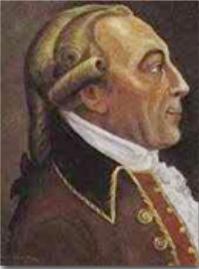Schröter, Johann Hieronymous (1745–1816)
Johann Schröter was a German astronomer, with a passion for lunar and planetary observation, who set up a private observatory at Lilienthal, near Bremen, and produced the most detailed study of the Moon up to that time. Schröter was born in Erfurt. In 1764 he began his studies in Law at Göttigen University, during which he developed an extracurricular interest in mathematics and astronomy. Upon graduation he embarked on a high level administrative career that occupied him fully for the following ten years. Schröter's astronomical leanings were rekindled via his interest in music, which led to his acquaintance with the Herschel family, and, in particular, William Herschel, in England, destined become the foremost astronomer of the 18th century.
 |
In 1772, Schröter began his astronomical work in earnest with the founding of his observatory. Financially secured through his appointment as district governor and judge, he carried out planetary and solar observations almost continuously for the rest of his life. Many of his telescopes were purchased from William Herschel, with whom he also exchanged scientific correspondence. Schröter's Lilienthal observatory was for a time home to the largest telescope in continental Europe. In 1810 the Napoleonic invasion of Northern Germany brought dire times to Lilienthal, in particular in 1813, when retreating French imperial troops destroyed a good part of the town. Although Schröter's observatory and instruments were left untouched, he lost many of his observational notebooks and unpublished scientific manuscripts, destroyed along with the Lilienthal town hall.
Schröter was primarily interested in solar and planetary astronomy. He was the first, in 1787, to notice and comment upon the solar surface feature now known as granulation. He also gave detailed descriptions of light bridges over the umbrae of sunspots. He carried out many observations of Venus and tried to determine its rotation period. His two volumes on lunar topography reached levels of detail that were to remain for many years unsurpassed.
On Sep 20, 1800, Schröter presided over the founding of the first astronomical society, with members distributed all over Europe. One of the foremost aim of the society was to organize a systematic observing program to detect a planet between the orbits of Mars and Jupiter, the presence of which being suggested by the Titius-Bode numerical relationship popularized in 1772 by Johann Elert Bode, a friend of Schröter. By 1807 various members of the society had discovered the four large asteroids Ceres, Pallas, Vesta, and Juno. Schröter's reputation in planetary astronomy was sufficient to attract Friedrich Wilhelm Bessel to Lilienthal, where he remained for a few years as an assistant.
Schröter was an enthusiastic pluralist who wrote that he was "fully convinced that every celestial body may be so arranged physically by the Almighty as to be filled with living creatures ..." He claimed to have detected an atmosphere, mountains, and an Earth-like period of rotation on Venus and Mercury, both of which he considered to be inhabited. Color changes he reported seeing on the Moon were attributed to areas under cultivation, and although, in 1792, he estimated that the lunar atmosphere was 29 times more tenuous than that of Earth, he felt confident enough to write that:
I at least imagine ... [the] gray surface of Maris Imbrium to be just as fruitful as the Campanian plain [of Italy]. Here nature has ceased to rage, there is a mild and beneficial tract given over to the calm culture of rational creatures ...
Like his compatriot Gruithuisen, who followed him on the pro-selenite trail, and Lowell, a century later, he allowed too often his preconceived ideas about the presence of extraterrestrial life to color his observations or the inferences he drew from them.


